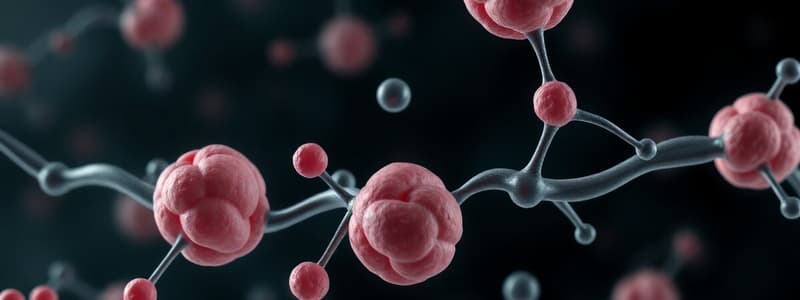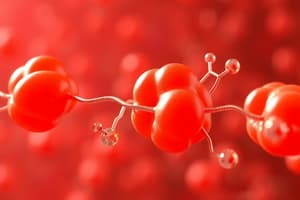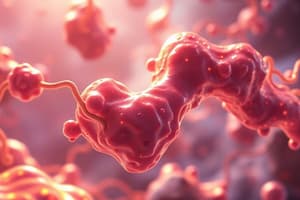Podcast
Questions and Answers
What is the primary function of chylomicrons in lipid metabolism?
What is the primary function of chylomicrons in lipid metabolism?
- Synthesize lipoproteins in the liver
- Act as receptors for lipoprotein metabolism enzymes
- Transport dietary triglycerides and cholesterol to peripheral tissues (correct)
- Transport endogenous triglycerides from the liver
Which apolipoprotein is primarily associated with chylomicron receptor binding?
Which apolipoprotein is primarily associated with chylomicron receptor binding?
- Apo A-I
- Apo B-100
- Apo B-48 (correct)
- Apo C-II
What is the composition of very-low-density lipoprotein (VLDL)?
What is the composition of very-low-density lipoprotein (VLDL)?
- 70% lipid, 30% protein
- 90% lipid, 10% protein (correct)
- 90% protein, 10% lipid
- 50% lipid, 50% protein
What role does Apo C-II play in lipoprotein metabolism?
What role does Apo C-II play in lipoprotein metabolism?
Which lipoprotein is synthesized from VLDL during its degradation?
Which lipoprotein is synthesized from VLDL during its degradation?
In which condition does chylomicron accumulation occur due to enzyme deficiency?
In which condition does chylomicron accumulation occur due to enzyme deficiency?
What does low-density lipoprotein (LDL) primarily transport?
What does low-density lipoprotein (LDL) primarily transport?
What characterizes the lipid composition of high-density lipoproteins (HDL)?
What characterizes the lipid composition of high-density lipoproteins (HDL)?
What condition is primarily caused by a deficiency in functional LDL receptors?
What condition is primarily caused by a deficiency in functional LDL receptors?
Which apolipoprotein is responsible for activating lecithin-cholesterol acyltransferase (LCAT)?
Which apolipoprotein is responsible for activating lecithin-cholesterol acyltransferase (LCAT)?
What is the net ATP yield from the beta-oxidation of palmitic acid?
What is the net ATP yield from the beta-oxidation of palmitic acid?
Where does beta-oxidation primarily take place within the cell?
Where does beta-oxidation primarily take place within the cell?
What happens to fatty acids during prolonged fasting?
What happens to fatty acids during prolonged fasting?
The final product of beta-oxidation for fatty acids with an odd number of carbon atoms is:
The final product of beta-oxidation for fatty acids with an odd number of carbon atoms is:
What is one key factor that regulates beta-oxidation?
What is one key factor that regulates beta-oxidation?
Which of the following is a major function of high-density lipoprotein (HDL)?
Which of the following is a major function of high-density lipoprotein (HDL)?
Which enzyme is responsible for the breakdown of stored triacylglycerol in adipose tissue?
Which enzyme is responsible for the breakdown of stored triacylglycerol in adipose tissue?
What is the primary condition that promotes lipolysis?
What is the primary condition that promotes lipolysis?
Which substance is NOT classified as a ketone body?
Which substance is NOT classified as a ketone body?
What effect does insulin have on lipolysis?
What effect does insulin have on lipolysis?
What are the causes of ketosis?
What are the causes of ketosis?
Which hormone is considered to stimulate lipolysis?
Which hormone is considered to stimulate lipolysis?
Where is the primary site of ketone body synthesis?
Where is the primary site of ketone body synthesis?
Caffeine aids lipolysis through its effect on which enzyme?
Caffeine aids lipolysis through its effect on which enzyme?
What is the primary site of fatty acid synthesis within the body?
What is the primary site of fatty acid synthesis within the body?
Which of the following is NOT involved in the regulation of fatty acid synthesis?
Which of the following is NOT involved in the regulation of fatty acid synthesis?
During fatty acid biosynthesis, what molecule serves as the direct source of all carbon atoms?
During fatty acid biosynthesis, what molecule serves as the direct source of all carbon atoms?
What process occurs primarily with medium-chain fatty acids during hydroxylation?
What process occurs primarily with medium-chain fatty acids during hydroxylation?
How many turns of the cycle are needed to synthesize palmitic acid from butyryl-ACP?
How many turns of the cycle are needed to synthesize palmitic acid from butyryl-ACP?
Which of the following components is NOT a building block for fatty acid synthesis?
Which of the following components is NOT a building block for fatty acid synthesis?
What happens to free palmitate before it can enter other metabolic pathways?
What happens to free palmitate before it can enter other metabolic pathways?
What characterizes α-oxidation in fatty acid metabolism?
What characterizes α-oxidation in fatty acid metabolism?
What is produced when palmitate is combined with glycerol?
What is produced when palmitate is combined with glycerol?
Which fatty acid is formed when stearic acid undergoes desaturation?
Which fatty acid is formed when stearic acid undergoes desaturation?
What is the role of citrate in fatty acid synthesis?
What is the role of citrate in fatty acid synthesis?
Which of the following inhibits acetyl CoA carboxylase?
Which of the following inhibits acetyl CoA carboxylase?
What is the primary substrate for the synthesis of glycerol phosphate in the liver?
What is the primary substrate for the synthesis of glycerol phosphate in the liver?
Which enzyme is involved in the activation of fatty acids to Acyl-CoA?
Which enzyme is involved in the activation of fatty acids to Acyl-CoA?
During chain elongation, palmitate can form fatty acids with how many carbons?
During chain elongation, palmitate can form fatty acids with how many carbons?
Which of the following is NOT a consequence of increased insulin levels in fatty acid synthesis?
Which of the following is NOT a consequence of increased insulin levels in fatty acid synthesis?
Where does ketone bodies oxidation primarily take place?
Where does ketone bodies oxidation primarily take place?
How much ATP is yielded from the oxidation of acetoacetate?
How much ATP is yielded from the oxidation of acetoacetate?
What is the primary source of endogenous cholesterol?
What is the primary source of endogenous cholesterol?
Which lipoprotein contains the majority of plasma cholesterol?
Which lipoprotein contains the majority of plasma cholesterol?
What effect does feeding cholesterol have on hepatic cholesterol biosynthesis?
What effect does feeding cholesterol have on hepatic cholesterol biosynthesis?
Which enzyme is considered the key regulator of cholesterol biosynthesis?
Which enzyme is considered the key regulator of cholesterol biosynthesis?
What happens to HMG-CoA reductase activity during fasting?
What happens to HMG-CoA reductase activity during fasting?
What is the main site of cholesterol synthesis in the body?
What is the main site of cholesterol synthesis in the body?
Flashcards
Chylomicrons
Chylomicrons
A type of lipoprotein responsible for transporting dietary triglycerides (TG), cholesterol, cholesterol esters, and fat-soluble vitamins from the small intestine to peripheral tissues.
Very Low Density Lipoproteins (VLDL)
Very Low Density Lipoproteins (VLDL)
A type of lipoprotein mainly synthesized in the liver, transporting endogenously produced triglycerides from the liver to peripheral tissues. They are composed primarily of lipids, including triglycerides, cholesterol, and phospholipids.
Intermediate Density Lipoprotein (IDL)
Intermediate Density Lipoprotein (IDL)
A type of lipoprotein formed during the breakdown of VLDL, serving as a precursor to LDL. They transport triglycerides and are involved in cholesterol metabolism.
Low Density Lipoprotein (LDL)
Low Density Lipoprotein (LDL)
Signup and view all the flashcards
High Density Lipoprotein (HDL)
High Density Lipoprotein (HDL)
Signup and view all the flashcards
Familial Chylomicronemia
Familial Chylomicronemia
Signup and view all the flashcards
Apolipoproteins
Apolipoproteins
Signup and view all the flashcards
Lipoprotein Lipase (LPL)
Lipoprotein Lipase (LPL)
Signup and view all the flashcards
Beta-oxidation
Beta-oxidation
Signup and view all the flashcards
Familial Hypercholesterolemia
Familial Hypercholesterolemia
Signup and view all the flashcards
Acyl-carnitine
Acyl-carnitine
Signup and view all the flashcards
Oxidation of Fatty Acids with Odd Number of Carbon Atoms
Oxidation of Fatty Acids with Odd Number of Carbon Atoms
Signup and view all the flashcards
α-oxidation
α-oxidation
Signup and view all the flashcards
Regulation of Beta-oxidation
Regulation of Beta-oxidation
Signup and view all the flashcards
Propionyl CoA
Propionyl CoA
Signup and view all the flashcards
What is the result of ω-oxidation?
What is the result of ω-oxidation?
Signup and view all the flashcards
Fatty acid synthesis
Fatty acid synthesis
Signup and view all the flashcards
What is palmitic acid?
What is palmitic acid?
Signup and view all the flashcards
What is the elongation step in fatty acid synthesis?
What is the elongation step in fatty acid synthesis?
Signup and view all the flashcards
What is the main building block for fatty acid synthesis?
What is the main building block for fatty acid synthesis?
Signup and view all the flashcards
How does insulin affect fatty acid synthesis?
How does insulin affect fatty acid synthesis?
Signup and view all the flashcards
What is acetyl CoA carboxylase?
What is acetyl CoA carboxylase?
Signup and view all the flashcards
Chain Elongation of Fatty Acids
Chain Elongation of Fatty Acids
Signup and view all the flashcards
Desaturation of Fatty Acids
Desaturation of Fatty Acids
Signup and view all the flashcards
Acetyl CoA Carboxylase
Acetyl CoA Carboxylase
Signup and view all the flashcards
Citrate and Fatty Acid Synthesis
Citrate and Fatty Acid Synthesis
Signup and view all the flashcards
Insulin and Fatty Acid Synthesis
Insulin and Fatty Acid Synthesis
Signup and view all the flashcards
Long Chain Acyl CoA and Fatty Acid Synthesis
Long Chain Acyl CoA and Fatty Acid Synthesis
Signup and view all the flashcards
Triacylglycerol Synthesis
Triacylglycerol Synthesis
Signup and view all the flashcards
Glycerol Phosphate Production in Triacylglycerol Synthesis
Glycerol Phosphate Production in Triacylglycerol Synthesis
Signup and view all the flashcards
What is lipolysis?
What is lipolysis?
Signup and view all the flashcards
Which factors stimulate lipolysis?
Which factors stimulate lipolysis?
Signup and view all the flashcards
Which factors inhibit lipolysis?
Which factors inhibit lipolysis?
Signup and view all the flashcards
What are ketone bodies and what is their function?
What are ketone bodies and what is their function?
Signup and view all the flashcards
What is ketosis?
What is ketosis?
Signup and view all the flashcards
What are the causes of ketosis?
What are the causes of ketosis?
Signup and view all the flashcards
Where are ketone bodies synthesized?
Where are ketone bodies synthesized?
Signup and view all the flashcards
What is the role of glycerol kinase in triacylglycerol synthesis?
What is the role of glycerol kinase in triacylglycerol synthesis?
Signup and view all the flashcards
Where does ketone body oxidation occur?
Where does ketone body oxidation occur?
Signup and view all the flashcards
What is the energy yield from ketone body oxidation?
What is the energy yield from ketone body oxidation?
Signup and view all the flashcards
What are the sources of cholesterol?
What are the sources of cholesterol?
Signup and view all the flashcards
How is cholesterol transported in the blood?
How is cholesterol transported in the blood?
Signup and view all the flashcards
What are the functions of cholesterol?
What are the functions of cholesterol?
Signup and view all the flashcards
Where and how is cholesterol synthesized?
Where and how is cholesterol synthesized?
Signup and view all the flashcards
How is cholesterol biosynthesis regulated?
How is cholesterol biosynthesis regulated?
Signup and view all the flashcards
Study Notes
Lipid Metabolism
- Lipids are a major source of energy for the body
- About 100-150 grams of lipids are consumed daily by adults.
- Triacylglycerols (TGs) are the primary dietary lipids, constituting most fat and oils.
- Phospholipids and cholesterol are also present in the diet.
- Pancreatic lipase is crucial for TG digestion, activated by bile salts and calcium ions.
- Ingested TGs are emulsified in the stomach by gastric contractions and in the intestines by bile salts.
- Lipases then hydrolyze TGs into smaller components in the small intestine.
- End products of TG digestion are 2 monoacylglycerols, 1 monoacylglycerols, glycerol and saturated/unsaturated fatty acids.
- Short-chain fatty acids (<12 carbons) and glycerol are water-soluble and absorbed directly into the portal system, leading to the liver.
- Other lipids (long-chain fatty acids) combine with bile salts to form micelles, enhancing absorption into mucosal cells in the intestines.
- Absorbed long-chain fatty acids are re-esterified into TGs within the intestinal cells.
- These TGs, along with cholesterol and phospholipids, are assembled into chylomicrons.
- Chylomicrons enter the lymphatic system, eventually entering the bloodstream at the thoracic duct.
- Lipoprotein lipase (LPL) hydrolyzes chylomicron TGs into free fatty acids and glycerol, enabling absorption by tissue cells.
- These fatty acids are then metabolized for energy or stored as TGs within the tissue cells.
- The body uses different types of lipoproteins to transport lipids within the bloodstream (chylomicrons, VLDL, IDL, LDL, and HDL). These lipoproteins differ in lipid and protein composition, size, and density, all crucial for lipid transportation.
Digestion and Absorption
- Digestion of lipids starts in the small intestine.
- The emulsified TGs are hydrolyzed by pancreatic lipase.
- The result of the hydrolysis can be 2-monoacylglycerol or 1-monoacylglycerol, which can be further hydrolyzed to free glycerol.
- The end products are 2 monoacylglycerols, 1 monoacylglycerols, glycerol and saturated/unsaturated fatty acids.
Plasma Lipids
- Lipids within the bloodstream are transported by lipoproteins.
- These lipoproteins have different functions based on their composition and sizes (e.g., Chylomicrons, VLDL, IDL, LDL, HDL).
- Apolipoproteins (Apo) are proteins associated with lipoproteins.
- Apolipoproteins serve as receptors for cells and as activators/co-enzymes for enzymes involved in lipoprotein metabolism.
- Five major classes of apolipoproteins (A-E) with subclasses are important in lipid metabolism.
Oxidation of Fatty Acids
- Fatty acids are taken by cells and used for energy production.
- In prolonged fasting, tissues utilize fatty acids and/or ketone bodies.
- β–oxidation is the primary pathway for fatty acid breakdown.
- The β-carbon is oxidized in this process. This happens within the mitochondria.
- Fatty acids are not directly absorbed by mitochondria, forming acyl-carnitine to travel through the membranes.
Site
- Mitochondria are the primary site of fatty acid oxidation.
- The inner mitochondrial membrane is impermeable to fatty acids; therefore, fatty acids react with carnitine to generate acyl-carnitine which can enter the mitochondria.
Importance of β-oxidation
- Provides a source of energy.
- Generates acetyl CoA for energy production and other processes.
- The process of ketone body formation in the liver.
Oxidation of fatty acids with odd number of carbon atoms
- Fatty acid oxidation with odd number of carbon atoms proceeds similarly to even-numbered fatty acids.
- However, propionyl CoA is the final product.
- Propionyl CoA is converted to succinyl CoA for entry into the citric acid cycle.
a-oxidation
- A minor pathway for fatty acid oxidation
- Oxidation of the carbon atom adjacent to the carboxyl group by removing a carbon.
- Happens primarily in brain tissue.
w-oxidation
- A minor pathway for fatty acid oxidation involving hydroxylation in the endoplasmic reticulum.
- Hydroxylation typically occurs on the methyl carbon.
- The hydroxylated fatty acid can be further oxidized to a dicarboxylic acid.
- Occurs with medium-chain fatty acids.
Biosynthesis of fatty acids (Lipogenesis)
- Occurs in the liver and adipose tissue cytosol.
- Acetyl CoA is a crucial precursor for fatty acids.
- The process utilizes NADPH as a source of reducing equivalents.
- Requires ATP for many enzymatic processes.
- It is an energetically expensive process.
- Lipogenesis mainly occurs during and after consumption of a carbohydrate- rich meal.
Palmitate Formation
- Palmitic acid (16-carbon saturated fatty acid) is the primary product.
- Palmitic acid is released from the fatty acid synthase complex.
- The cycle continues after each repetition.
Fate of palmitate
- Palmitate can be used in different processes, including esterification with glycerol or cholesterol.
- Elongation can increase the number of carbon atoms in palmitate.
- Desaturation introduces double bonds to produce other fatty acids.
Regulation of fatty acid biosynthesis
- Insulin stimulates fatty acid synthesis by influencing acetyl-CoA carboxylase.
- Citrate activates acetyl-CoA carboxylase, also known as the rate-limiting step in fatty acid synthesis.
- Long-chain acyl CoAs inhibit acetyl-CoA carboxylase, thus reducing synthesis.
Triacylglycerol Metabolism
- TGs are synthesized in adipose tissue as the major energy storage.
- Fatty acids must first be activated to acyl-CoA.
- Glycerol phosphate is synthesized from glucose or glycerol by two primary methods.
- These two forms of glycerol phosphate are important in the synthesis of triacylglycerol.
Lipolysis (TG Degradation)
- This process breaks down stored TGs into glycerol and fatty acids in adipose tissue.
- Increased energy demand (i.e., starvation, uncontrolled diabetes, low carbohydrate diet) leads to higher lipolysis.
- Hormone-sensitive lipase (HSL) enzyme plays a crucial role in lipolysis.
Lipolysis Regulations
- Several hormones (epinephrine, nor epinephrine, growth hormone, TSH, and caffeine) stimulate lipolysis.
- Insulin can inhibit lipolysis through the inhibition of cAMP-dependent protein kinase.
- Long-chain acyl-CoA inhibits acetyl-CoA carboxylase, lowering rates of fatty acid synthesis.
- Nicotinic acid and prostaglandin E reduce lipolysis through their effects on adenylate cyclase.
Ketone Bodies Metabolism
- Ketone bodies are produced by the liver primarily during periods of starvation or carbohydrate restriction or with diabetes.
- The liver creates ketone bodies from acetyl CoA.
- During starvation or diabetes, the body utilizes ketone bodies from the liver as an energy source.
- Ketone bodies include acetoacetic acid, β-hydroxybutyric acid, and acetone.
- These compounds provide energy for vital organs like the heart and skeletal muscle.
- The synthesis primarily happens in the liver from molecules like acetyl CoA.
Ketosis
- Ketosis is a metabolic condition characterized by elevated levels of blood and urine ketone bodies.
- Conditions such as starvation, carbohydrate-poor diets, and uncontrolled diabetes can induce ketosis.
Ketone Bodies Oxidation (Ketolysis)
- Extrahepatic tissues primarily utilize ketone bodies for energy.
- Liver lacks the key enzymes for ketone body breakdown.
- Oxidation of ketone bodies follows specific pathways.
- Results in the generation of ATP.
Metabolism of Cholesterol
-
Cholesterol is synthesized within the body.
-
The main site of cholesterol production is the liver.
-
Other tissues such as adrenal cortex, skin, testis, and intestine also synthesize cholesterol.
-
Cholesterol synthesis occurs within the cytoplasm of cells.
-
The process begins from acetoacetyl coA and mevalonate from active acetyl CoA.
-
The key enzyme in cholesterol synthesis is HMG-CoA reductase.
-
Cholesterol intake decreases HMG-CoA reductase activity.
-
Fasting reduces cholesterol production by limiting the availability of acetyl CoA and NADPH.
-
Cholesterol can undergo reversible phosphorylation-dephosphorylation.
-
The phosphorylated form is less active.
-
Cholesterol is crucial for many bodily functions, including the structure of cells and hormones.
-
Excess cholesterol can lead to health problems.
-
Cholesterol can be excreted from the body via bile acids and bile salts in the feces.
-
Some cholesterol undergoes modification by bacteria into coprostanol and cholestanol.
-
Plasma cholesterol exists as free cholesterol and cholesteryl esters.
Studying That Suits You
Use AI to generate personalized quizzes and flashcards to suit your learning preferences.




